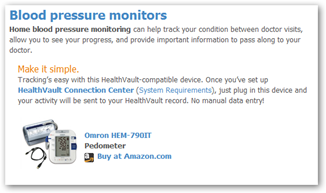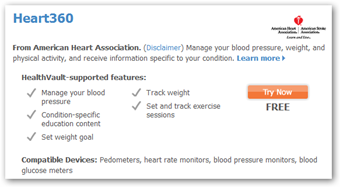The findings were announced today at this year’s American Heart Association Forum on Quality of Care and Outcomes Research in Cardiovascular Disease and Stroke  that patients were more than 50% likely to have their blood pressure control tactics in place. Some of this is common sense, in the fact that if we “see” and look at the information, we learn.
that patients were more than 50% likely to have their blood pressure control tactics in place. Some of this is common sense, in the fact that if we “see” and look at the information, we learn.
The process here made it easy for the patients too without taking additional time for data input, which we all love to hate sometimes with the busy schedules we all have today. When you make it simple, easy and automated for review, people tend to take an interest, especially if they have any bouts of not feeling well, etc. I know tend to want to do the same, take a look and see what is going on and blood pressure is something we all pretty much look at today and is one of the first items conducted in a visit to the doctor’s office, so this way we can be one step ahead and take a look before rolling up our shirt sleeves at the doctor’s office.
This also shows how the HealthVault PHR was the software vehicle used to collect the information and the interaction between the system at Kaiser Permanente to import the data for analysis for the study results – data working together and patient medications were adjusted according to what was perhaps working and what needed another look, in other words too much, too little, a different medication, and so on. BD
Friday, May 21, 2010, DENVER and REDMOND -- The use of at-home blood pressure monitors and web-based reporting tools that connect clinicians and patients via the Internet appears to significantly improve patients’ ability to manage their high blood pressure to healthy levels, according to research from Kaiser Permanente.
The study, led by Kaiser Permanente Colorado in collaboration with the American Heart Association and Microsoft Corp., involved 348 patients with uncontrolled hypertension, ages 18-85 years. The initial study data was presented today by Kaiser Permanente Colorado researchers at the American Heart Association’s 11th Scientific Forum on Quality of Care and Outcomes Research in Cardiovascular Disease and Stroke.
"Kaiser Permanente Colorado’s Institute for Health Research is committed to studying innovative ways to make care more patient-centered in order to improve quality,” said lead author David Magid, MD, Kaiser Permanente senior scientist. “While more research is necessary, our study suggests that using technology to engage individuals in their care at home may be a better way to help patients achieve a healthy blood pressure.”
As many as 73 million Americans have high blood pressure (hypertension), a leading predictor of heart disease. According to the American Heart Association, approximately 69 percent of people who have a first attack and 77 percent who have a first stroke suffer from elevated blood pressure levels. The participants were randomized to a usual care group or a home monitoring group. All patients had their blood pressure measured in the medical office at the start of the six-month study. The usual care group was managed in a typical model that involved checking blood pressure during office visits.
The home monitoring group used an at-home blood pressure device that uploaded data to the patient’s account in Microsoft HealthVault, a security enhanced,  Web-based data storage platform. At the time of entering the study, the participants opted into a Kaiser Permanente application that automatically transferred the home blood pressure readings to Kaiser Permanente’s electronic disease registry.
Web-based data storage platform. At the time of entering the study, the participants opted into a Kaiser Permanente application that automatically transferred the home blood pressure readings to Kaiser Permanente’s electronic disease registry.
Kaiser Permanente’s clinical pharmacists used the computerized registry to monitor readings and consulted with patients to adjust their antihypertensive medications based on proven protocols. Connected to HealthVault, patients were able to manage their data using Heart360, a free online tool provided by the American Heart Association.
At the start of the study, the average systolic blood pressure was 149 mm Hg in the home monitoring group and 145 mm Hg in the usual care group. At six months, patients in the home monitoring group were 50 percent more likely to have their blood pressure controlled to healthy levels compared to the usual care group. Similarly, a significantly greater decrease in systolic blood pressure at six months occurred in the home monitoring group (-21 mm Hg) versus the usual care group (-9 mm Hg).
Health experts have long known that the current approach to managing hypertension has its shortcomings. Patients often don’t comply with in-person visits and when they do, the measurements can be inconsistent or inaccurate. In light of these shortcomings, the American Heart Association recently began recommending home monitoring. However, prior research conducted by Dr. Magid found that when patients used home monitoring, but were required to write down and call-in results, blood pressure goals only slightly improved. This latest study provides an additional layer of automation and convenience by directly feeding the readings from the home blood pressure cuff to the patient’s care team via sophisticated health-IT tools.
“While the in-person doctor-patient relationship will always be a cornerstone of care, one day the use of coordinated, secure health information technologies based at home or work could complement visits in a medical office,” noted coauthor Kari Olson, PharmD, a clinical pharmacy specialist at Kaiser Permanente Colorado.
"Engaging patients with tools that make health management more accessible is a critical step in addressing the alarming growth of chronic diseases and associated increase in costs,” said Peter Neupert, corporate vice president of the Health Solutions Group at Microsoft. "The preliminary results of this clinical trial are significant and demonstrate how cost-effective and flexible technology solutions can encourage patients to be active partners in their health and help decrease their risk for life-threatening, acute care incidents."
This Kaiser Permanente Colorado research is part of a larger effort at Kaiser Permanente to study remote monitoring and connected telehealth to deliver health care at a distance outside of the traditional health care facilities.
About Microsoft HealthVault
Microsoft HealthVault is a personal health application platform designed to put consumers in control of their health information. HealthVault provides a privacy- and security-enhanced foundation on which a broad ecosystem of providers can build innovative health and wellness solutions such as personal health records, disease management, fitness, weight loss and other Web applications. HealthVault can be used to collect and store health information that would otherwise reside in disparate systems and transfer the information between a variety of providers’ health services and systems. It enables the reuse and free flow of interoperable and transportable personal health information.
More information is available at http://www.healthvault.com.
About Microsoft
Founded in 1975, Microsoft (Nasdaq “MSFT”) is the worldwide leader in software, services and solutions
that help people and businesses realize their full potential.
About Kaiser Permanente
Kaiser Permanente is committed to helping shape the future of health care. We are recognized as one of
America's leading health care providers and not-for-profit health plans. Founded in 1945, our mission is to provide high-quality, affordable health care services and to improve the health of our members and the communities we serve. We currently serve 8.6 million members in nine states and the District of Columbia.
Care for members and patients is focused on their total health and guided by their personal physicians, specialists and team of caregivers. Our expert and caring medical teams are empowered and supported by industry-leading technology advances and tools for health promotion, disease prevention, state-of-the art care delivery and world-class chronic disease management. Kaiser Permanente is dedicated to care innovations, clinical research, health education and the support of community health. For more information, go to: www.kp.org/newscenter.
http://www.kaiserpermanente.org



0 comments :
Post a Comment